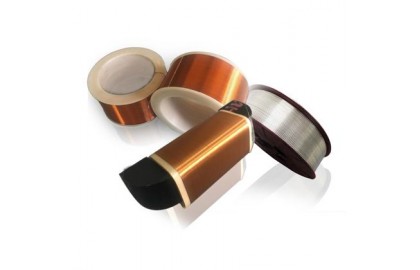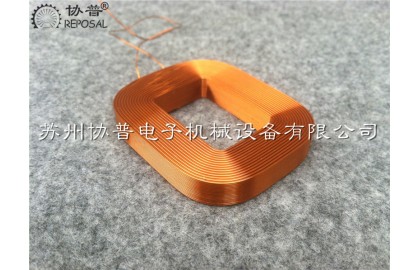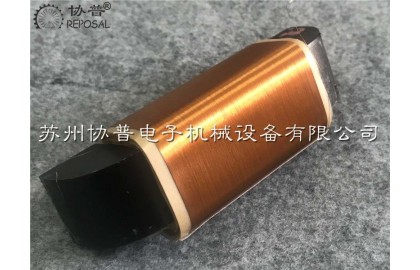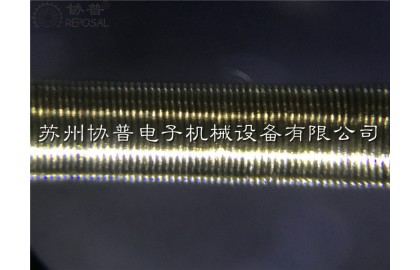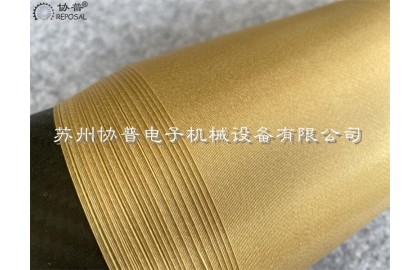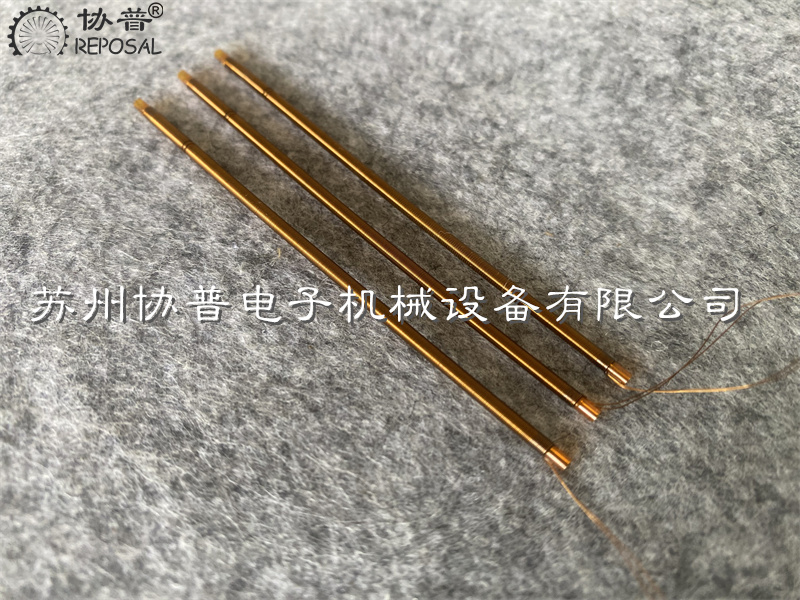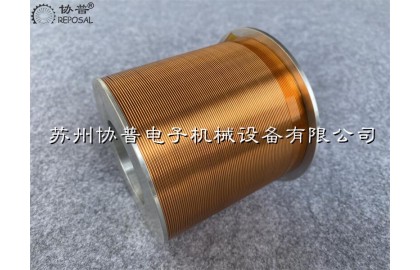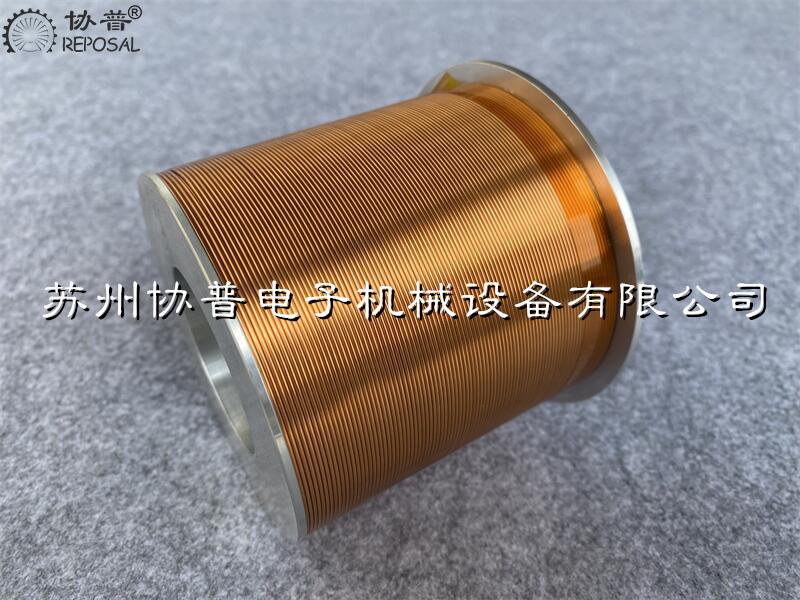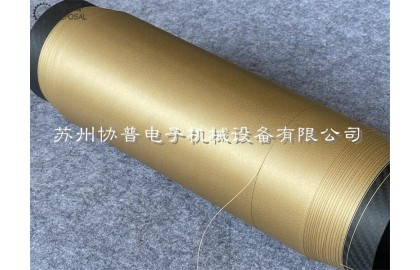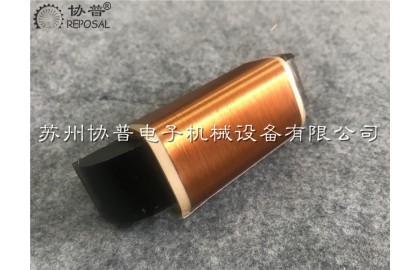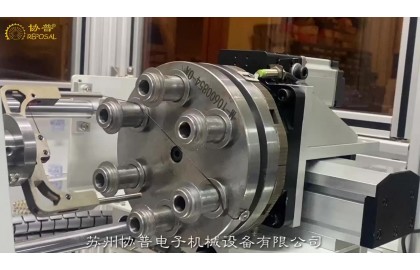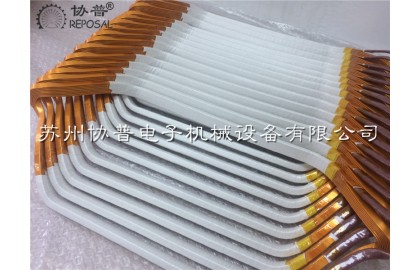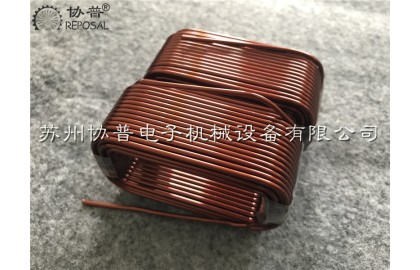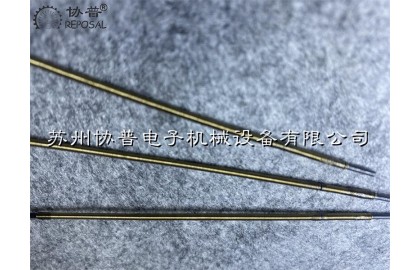REPOSAL® winding machine releases special winding machine for frequency divider inductors
REPOSAL® winding machine releases special winding machine for frequency divider inductors
In daily life, have you ever noticed more than one horn on your car? And more expensive cars have more horns. According to normal people's thinking, the car as long as there is a horn can emit sound signals on the line, more horn is why? The reason is very simple, for example, the turn signal and the warning horn are completely different, the sound frequency is different, and the sound range of the speakers used for high and low is naturally different. A single speaker cannot play a full frequency sound, and a sound may require a combination of multiple channels of sound to achieve a clear cue.
Therefore, in order to make each speaker emit audio suitable for it, it is necessary to use a tool such as a frequency divider. In simple words, the frequency divider is a filter circuit composed of a capacitor and a frequency divider inductor coil wound by the frequency divider winding machine. The capacitor filters the low frequency to the tweeter, and the frequency divider inductor is wound by the frequency divider winding machine to filter the high bottom to the low frequency to the woofer, so as to distinguish the sound signals in different frequency bands in a sound. It has different sound frequency channels, high frequency sound channels can only pass high frequency sound, middle and low frequency sound the same. After the sound is distinguished, the sound is amplified and played in the corresponding sound amplifier, and finally we can get the most accurate audio we want.
Frequency dividers are divided into two categories, one is a power divider, and the other is an electronic divider.
The power divider is set in the speaker, the power amplifier in the speaker first amplifies the sound power, and then the power divider divides it into three audio signals, high, middle and low, and finally sends it to different speakers for playback. The advantage of this power divider is that it is simple and convenient to connect and use, but its disadvantages are also obvious, that is, its power consumption is large and the parameter deviation value is large, the error of the sound frequency is large, and its error is related to the impedance of the speaker, so it is not convenient to adjust.
REPOSAL® Winding Machine successfully overcomes the difficulty in the winding process of closed coils of fixed-length titanium plates with loops.
REPOSAL® Winding Machine successfully overcomes the difficulty in the winding process of closed coils of fixed-length titanium plates with loops.
These tiny looped titanium plates are shown here, small metal structures approximately 12mm long, 4mm wide and 1.5mm thick, and have a row of four circular holes through them, two of which are for The main body pulls the suture through, and the other two upper holes are used for the passage of another group of seam lines. The structure is small in size, and it is necessary to form a closed connecting loop through the structural member, and the closed connecting loop is formed by twisting the yarn fibers of the loose structure. A closed high-strength braided coil is passed through the middle, which seems simple, but its core technology is reflected in the Loop, that is, a high-strength coil, which is woven evenly, tightly, non-woven, and without joints.
This kind of titanium plate with loops is divided into two types, fixed-length type and adjustable type, especially the fixed-length type, whose length ranges from 15mm to 60mm. It is necessary to wind this closed loop in the middle of a titanium plate with such a small volume. Coils, and because the number of colonies cannot exceed the standard, cannot be wound by hand, but must be wound by
equipment, which is extremely difficult to process. Its structural parts are small in size, and the diameter of the holes is only 1-1.5mm. It needs to form twisted yarns under such conditions, so this product has always been processed manually by hand, and its efficiency is low and consistent. Sex is hard to guarantee.
Because of the small size of the structure, the diameter of the hole is only 1-1.5mm, and it needs to form twisted yarn under this condition, so this product has been processed manually, and its efficiency is low. Consistency is difficult to guarantee.
REPOSAL® Winding Machine successfully developed this equipment according to the customer's request, completed the simultaneous formation of a closed loop (including fiber bundles with a loose structure) and passed it to the porous structural parts, and maintained the twisted structure, which greatly improved the closed loop. The winding efficiency, in addition to obtaining the incomparable consistency of pure hand-made, makes the product have the conditions for large-scale production.
REPOSAL® Winder Releases Coded Teach Winder Control System
REPOSAL® Winding Machine Releases Code-Type Teaching Winding Machine Control System
REPOSAL® Winding Machine, a domestic coil intelligent manufacturing solution provider, has launched its new generation of code programming teaching type winding machine control system that is more open, intelligent and highly autonomous for coil winding enterprises - REPOSAL® Winding machine SP500-R5 system. Compared with the traditional dialog-type winding machine control system, the SP500-R5 system has achieved major breakthroughs in operation logic, technical architecture, and function implementation. Features.
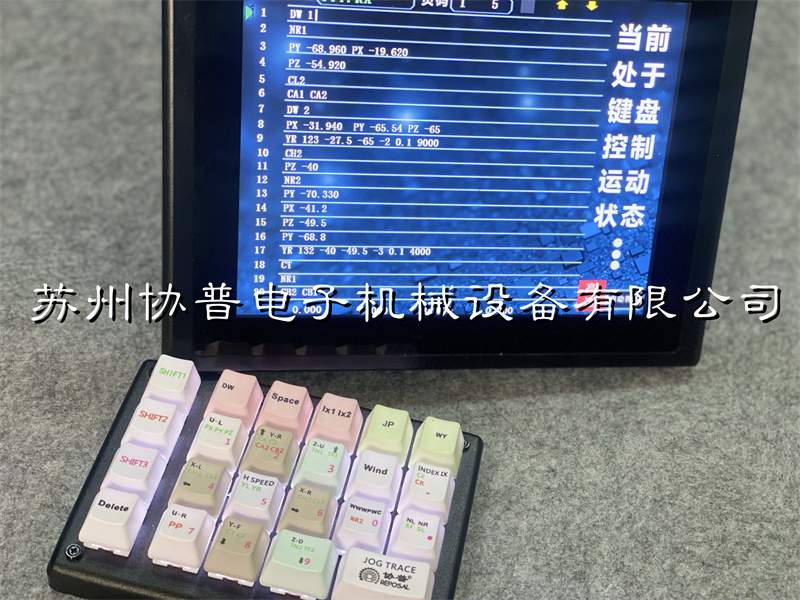
The SP500-R5 system adheres to the concept of "openness and intelligence". Based on the functions of the traditional dialog-based winding machine control system, it integrates the actual needs of the winding factory, and is committed to realizing the coil winding process programming process from the traditional parameter dialog. A major innovation and upgrade from control to code teaching programming.
REPOSAL®winding machine's advantages in crossover winding machines
REPOSAL has invested a lot of R&D efforts in the field of crossover coil winding machines and has achieved a series of remarkable results.
In terms of winding accuracy, through in-depth research and optimization of the wiring mechanism and control system, REPOSAL's divider coil winding machine can control the winding accuracy within a very small error range. For example, for the wire with a thin wire diameter, the winding machine can accurately wind according to the set number of turns and arrangement, to ensure that the position accuracy of each turn of wire reaches ±0.05 mm, which greatly improves the quality and performance stability of the coil, and makes the crossover more accurate in the audio signal processing.
In terms of improving winding efficiency, REPOSAL has developed a unique high-speed winding technology. Thanks to the use of an advanced motor drive system and an efficient drive, the winding speed of the winding machine is increased by 30% compared to conventional models. At the same time, combined with the intelligent control system, continuous and uninterrupted winding can be realized, which greatly shortens the winding time of a single coil. For example, a common divider coil that used to take about 10 minutes to be wound by hand, but only 3 to 4 minutes with REPOSAL's winding machine significantly improved production efficiency and provided strong support for large-scale production.
In terms of versatility, REPOSAL's crossover coil winders are highly adaptable. By designing replaceable winding dies and flexible parameter adjustment functions, it is possible to wind a wide range of divider coils with different specifications, shapes and parameter requirements. Whether it's a crossover coil for a miniaturized audio device or a crossover coil for a large professional audio system, high-quality winding can be achieved on the same winding machine. For example, for coil skeletons with different inner diameters, outer diameters and height requirements, the winding machine can quickly switch production modes through simple mold change and parameter setting to meet diverse market needs.
In addition, REPOSAL also pays attention to the research on the convenience and intelligence of the winding machine. A concise and easy-to-understand human-computer interface has been developed, so that operators can master the operation method with only simple training. At the same time, the winding machine also has intelligent fault diagnosis and early warning function, which can monitor the parameters in the winding process in real time, and once there is an abnormal situation, such as wire breakage, abnormal winding tension, etc., it will immediately send out an alarm and prompt the cause of the failure, which is convenient for the operator to deal with in time and reduce the risk of production interruption and equipment damage.
Congratulations on our winding machine successfully passed the EU CE certification, enter the international market
Congratulations on our winding machine successfully passed the EU CE certification, enter the international market
In response to the international market's requirements for the safety and quality of our winding equipment, recently, our series of winding machines have won the CE certification issued by the European Union certification body. This marks the recognition of the EU market for the |REPOSAL® winding machine, which means that our company has the ability to provide more professional and high-quality winding machine equipment for the international coil market, and further enhance the company's international competitiveness.

REPOSAL® Winding machine CE certification certificate
On the one hand, in response to the national "Belt and Road" call, REPOSAL® winding machine actively explore overseas markets. The passing of the EU CE certification not only opens the European market, but also the first step to open the global market, which means that the company's winding machine can be exported to various countries in the European Union, and the pursuit of free circulation of our winding equipment in the global scope has a positive effect on the company's expansion of overseas winding machine market and international business expansion. At the same time, it also provides safety and quality assurance for the sales of the winding machine in the domestic market, and enhances the brand influence of the winding machine.
Enameled wire production process
Enameled wire technological process: pay-off→anneal→paint→baking→cooling→take-up
1. Pay-off On a normally operating enameled machine, most of the operator's energy and physical strength are consumed in the pay-off part. The replacement of the pay-off reel makes the operator pay a lot of labor, and the joints are prone to quality problems when changing the line. An operating failure has occurred. An effective method is to pay off with large capacity.
The key to pay off is to control the tension. When the tension is large, it will not only draw the conductor thin, make the surface of the wire lose its brightness, but also affect many properties of the enameled wire. From the appearance point of view, the enameled wire that is drawn thinner has poor gloss; from the performance point of view, the elongation, resilience, flexibility, and thermal shock of the enameled wire are all affected. If the pay-off tension is too small, the line will easily jump and cause the line to be merged and the line to touch the furnace mouth. When paying off, the most fear is that the half-turn tension is high and the half-turn tension is small. This will not only cause the wires to loosen, break, and be thinned section by section, but also cause large jumps of the wires in the oven, resulting in failures of merging and touching the wires. Pay-off tension should be even and appropriate.
Installing a booster wheel in front of the annealing furnace is very helpful for tension control. The maximum non-extension tension of soft copper wire at room temperature is about 15kg/mm2, the maximum non-extension tension at 400℃ is about 7kg/mm2; the maximum non-extension tension at 460℃ is 4kg/mm2; the maximum non-extension tension at 500℃ The extension tension is 2kg/mm2. In the normal enameled wire coating process, the tension of the enameled wire is significantly less than the non-extension tension, which is required to be controlled at about 50%, and the pay-off tension should be controlled at about 20% of the non-extension tension.
REPOSAL winding machine continuous innovation to consolidate brand value
Suzhou REPOSAL Electronic Mechanical Equipment Co., Ltd. is a technology enterprise specializing in R&D and production of winding equipment. For many years, it has insisted on maintaining innovation and researching and developing products with independent intellectual property rights.
For quite a long time, my country's winding machine manufacturing industry generally has the problems of low technology, small scale, free and scattered production, and insufficient technological innovation of most enterprises. Compared with related industries abroad, my country currently has fewer types of winding machines and supporting equipment. The control technology used is relatively backward, and its accuracy and performance are not as good as those of their European and American counterparts. Moreover, the product has low production capacity and poor stability.
In the face of technical gaps, Suzhou REPOSAL made a detailed market research and took the entire series of precision winding machines and Roche coil winding machines as breakthrough points.It valued cooperation with user companies and not only carefully understood the existing process requirements of customers. And through the company's accumulated technical database for many years, on the premise of no or little increase in costs, it actively provides new ideas and new solutions for customer process upgrades.In a specific single implementation case, this approach has undoubtedly aggravated us The execution cost of the company has reduced the company's profits, but this idea has been implemented and verified for a long time.In fact, our customers have tapped the potential of the coil winding process through our winding machine equipment and become our long-term cooperative customers. We have also accumulated more technical data for our research and development direction and solutions through proactive improvement of individual cases, so as to achieve continuous innovation.
REPOSAL ® winding machine has successfully realized the coil preparation process of the frameless capillary magnetic liquid acceleration sensor
In particular, the non-magnetic material in the magnetic liquid will be subjected to a magnetic field force in the non-uniform magnetic field, which makes many magnetic liquid acceleration sensors can be designed based on this characteristic.
These characteristics make the magnetic liquid acceleration sensor has many advantages compared with the traditional acceleration sensor, such as no wear, high sensitivity and simple structure.
However, most of the existing magnetic liquid acceleration sensors use solid mass blocks as non-magnetic substances, and use coils to detect changes in inductance under different accelerations to obtain output signals. However, its disadvantage is that it leads to complex magnetic circuit and poor sensor stability.
A new solution emerged -- the capillary magnetic liquid acceleration sensor, good stability, simple magnetic circuit, accurate and reliable measurement results and long service life.
REPOSAL ® winding machine to overcome guidance fiber wire winding process difficulties
Guidance communication has an excellent application prospect, but the guided fiber wire package needs to be wound long distance without defects, but because the surface of the fiber is smooth, brittle and easy to break, as well as the residual stress generated by the micro bending will make the signal attenuation, so it is more difficult to wind than other fibers, making long distance fast fiber automatic winding without defects has become a major issue. REPOSAL® winding machine, as a professional winding process solution provider, has been developing process research on precision winding of guided fiber wire packages for many years. Good progress has been made and REPOSAL® special winding machine for guidance fiber wire wrap developed by the winding machine can set reliable process instruction information according to process requirements and accurately execute control commands to finally finish the long distance guidance fiber wire wrap without defects. In the whole research project, we focus on solving three problems of guidance fiber optic wire wrapping system: tension control. Winding system, feeder system, and expand as follows.
REPOSAL® machine for radiofrequency ablation catheter
The precise winding process ensures the efficient transfer of energy, thereby improving the efficiency and consistency of ablation. The uniformity of the precision wound coil affects the temperature distribution of the ablation area, avoiding local overheating or heat deficiency, which is essential to ensure the ablation effect and reduce complications. The stability of the winding process ensures the reliability of the operation. The high-quality winding process withstands stretching and bending during surgical operations, reducing the risk of breakage or functional failure. High-quality winding processes have a longer service life and are able to maintain stable performance through multiple operations, thereby reducing medical costs and improving resource efficiency. The quality of the winding process also affects the precise control of the ablation process. The high-precision winding process helps physicians to more precisely control the size and shape of the ablation area to achieve optimal treatment results.
Moreover, the RFA catheter winder is designed with operational safety in mind, reducing potential risks during operation and protecting operators and products from damage. It can adapt to different types of radiofrequency ablation catheter production requirements, and has good flexibility and scalability. The structure and design of special winding machines are often more simplified and easier to maintain and maintain, thus reducing long-term operating costs.
The advantages of radiofrequency ablation catheter winding machine are mainly reflected in professional design, high efficiency production, precise control, quality stability, easy operation, material saving, safety, strong adaptability, low maintenance cost and technological innovation. These advantages make the radiofrequency ablation catheter winding machine an indispensable key equipment in the production process of radiofrequency ablation catheter.
REPOSAL® winding machine has successfully provided competitive solutions to the electron microscopy winding process
The main components of scanning electron microscope are electron optics system, signal collection and processing system, vacuum system, image processing display and recording system, power system and computer control system. The core part is the electron optical system, which is mainly composed of electron gun, electromagnetic condenser, diaphragm, scanning system, astigator, objective lens and various centering coils.
Reposal® winding machine As a professional supplier of precision winding solutions, we focus on the electromagnetic condenser, objective and astigmatic, because the main components are enamoured wire windings, and the precision and consistency of the windings are highly related to the image quality of the scanning electron microscope.
Electromagnetic lens coil.
The electromagnetic lens is mainly used to restrain the electron beam and it can be regarded as a convex lens in optics. Because the electron beam in a rotating symmetric magnetic field will be subjected to the Lorentz force, resulting in a focusing effect. Therefore, the quality of the enamelled wire winding coil that can generate this rotationally symmetric rather than uniform magnetic field and make the electron beam focus imaging is very important.
The enamelled wire winding coil in the magnetic lens, when the current passes through the coil, the pole shoe is magnetized, and a magnetic field is established in the heart cavity, producing a focusing effect on the electron beam. There are two kinds of enamelled wire winding in the magnetic lens, namely, the enamelled wire winding of the condenser and the enamelled wire winding of the objective lens. The lens near the electron gun is the enamelled wire winding of the condenser, while the one near the sample is the enamelled wire winding of the objective lens. General condenser is the high excitation lens enamelled wire winding, high excitation lens enamelled wire winding has many turns, a cylindrical multi-layer arrangement, requires good rotation symmetry
REPOSAL® Winding machine Optimum design of CNC winding machine for large power transformer
In the manufacture of power transformers, winding the transformer coil is a super important step, you think, the transformer coil is wound more firmly and neatly, the strength of the transformer and the ability to protect against short circuits can be greatly improved. However, most of the current transformer winding machines have to rely on manual extra sorting of the coil, the entire equipment is low in automation, and the production efficiency is not high, so the development of an excellent large transformer winding machine is a crucial thing for our company.

We have studied the main shaft technology of transformer winding machine, the relationship between compaction force and winding quality, and the control of compaction force. According to the principle and process flow of transformer winding, we put forward a whole design scheme of large transformer winding machine, including mechanical structure and electrical control. Mechanically, we simplify the complex structure of traditional transformer winders. In terms of electrical control, we ensure the stability of the motor when it starts and stops, and ensure that the winding coil is evenly tightened during the winding process. For the core parts of the transformer winding machine, spindle system and pressing device, we have calculated and selected the types and parameters. With the compaction device, we are able to provide real-time axial and radial compaction forces during the winding process of the transformer winding, which is very effective for improving the tightness of the winding.
The static analysis of the radial compaction device of the winding machine is also carried out by using finite element method, and the structure optimization is carried out according to the analysis results. We find that as the number of layers and turns of the winding increases, the required axial and radial compression forces change accordingly. By analyzing the experimental data, we find that there is a maximum value and a minimum value in the range of quality requirements, and it is the most reasonable choice to make the compression force approximately proportional to the number of layers and the number of turns.
The large transformer winding machine developed by our company has been preliminatively debugged and put into the market. After testing, the performance parameters of this transformer winding machine are in line with the design requirements, and the operation is stable and efficient. It can be wound to make a tight and regular transformer winding coil, and has been fully recognized by the market.
As a power grid equipment, power transformer converts voltage through the electromagnetic induction between the winding coils of the transformer. With the continuous development of the market, higher requirements are put forward for the manufacturing level of transformers, and the market needs more energy-saving and efficient transformers. Therefore, the optimization of the transformer manufacturing process is particularly critical. Quality and performance depend on the process equipment. The technical level of the transformer winding machine directly reflects the manufacturing level of the transformer. Therefore, accelerating the development of transformer winding machine is an important guarantee to improve the performance of transformer.
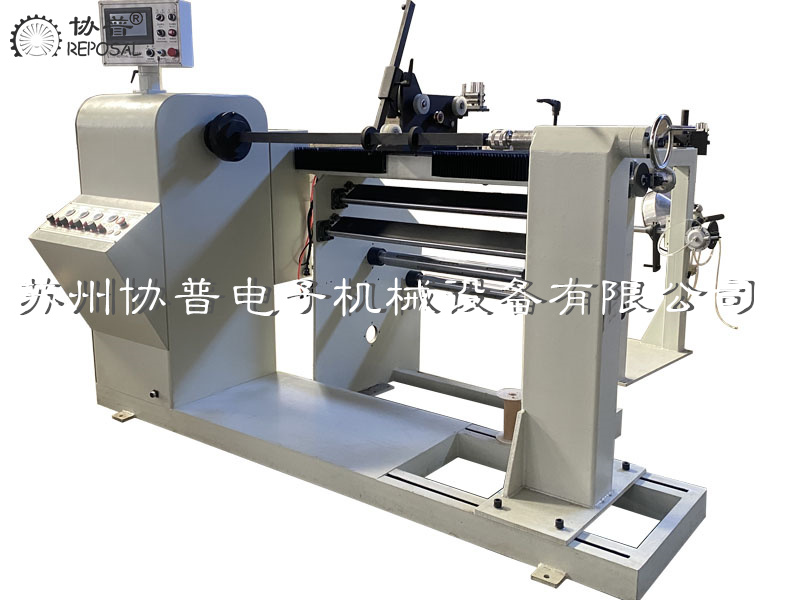
The winding coil of the transformer is the core component of the transformer and constitutes the electromagnetic induction part of the transformer. It generally includes high voltage winding and low voltage winding, respectively connected to the high voltage grid and low voltage grid. The winding of large power transformers usually adopts concentric winding, that is, the high and low voltage transformer winding coils are centrally set on the core column. The manufacture of transformer winding is the core process of transformer, and its quality plays a crucial role in the performance of transformer, affecting the appearance of transformer size, weight, mechanical properties, insulation and heat resistance and other important indicators.
In the past, the production of transformer winding coils relied on manual, and workers had to wind insulated wires manually to the winding die frame in accordance with the process requirements. Turns calculation also have to rely on manual, this old-fashioned method is inefficient, and because the worker's skills are not strong enough, the quality of the winding coil is poor, the number of turns may be miscalculated or missed, and ultimately lead to the finished winding coil performance can not be guaranteed. Later appeared semi-automatic transformer winding machine, which is driven by the motor to rotate the spindle to wind the transformer winding coil, although it improves the production efficiency, but the wiring work still has to rely on manual, only suitable for flat winding transformer winding coil winding, and winding head winding, welding and other operations must still be completed manually, so the product quality is not stable.
Later, with the emergence of TTL logic gate circuits, in the mid-1970s, with the development of CMOS technology, various types of equipment program control a large number of applications of digital integrated circuits, Western countries and Japan and other industrial powers have emerged CNC winding mechanism manufacturing industry. These CNC transformer winding machines represent the advanced level of winding mechanism manufacturing technology, especially the winding equipment produced in Japan, Italy, the United States and Germany is the leading technology.
Now the transformer winding machine as the core parts of the transformer production equipment, the market demand is very large, and the transformer manufacturing enterprises at home and abroad attach great importance to the development and application of advanced technology of transformer winding machine. Domestic transformer winding machine production enterprises are small, insufficient technical reserves, limited research and development funds, so there is still a big gap compared with foreign advanced products, the market share is low, unable to compete with foreign countries. To solve the key technical problems of transformer winding machine is the key to improve the quality of domestic winding equipment and enhance the market competitiveness. In order to meet the demand of transformer manufacturers for high quality and low price winding equipment, especially large transformer winding machine, on the basis of learning from foreign advanced experience, combined with domestic research results, the development of large transformer winding machine has important significance and practical value.
REPOSAL® winding machine wire guided missile fiber winding forming technology has made a new breakthrough
REPOSAL ® winding machine wire guided missile fiber winding forming technology has made a new breakthrough
Fiber optic guidance of wire-guided missile is a closed-loop guidance and control of controlled missile by bidirectional transmission of information and control signals between missile and launcher using special fiber optics.
Fiber optic guidance belongs to the wire guidance of remote control guidance, its advantages are not only high precision, strong anti-interference ability, can be equipped with optical cable shaft, micro camera, missile launch tail will release fiber, can control the missile and obtain target information.

The winding and release technology of optical fiber is a key technology of optical fiber guidance. At present, we have not realized automatic production in the production of optical fiber winding in our country, so we rely on the winding technical personnel's proficiency very high. The cross-turns working procedure of the winding process is still mainly manual operation, low production efficiency, high error probability and low consistency.
In addition to other ways to solve the high speed release of optical fiber, an important way is to ensure the smooth release of optical fiber through optical fiber winding. Optical fiber winding technology is the requirement of the pointer to the optical fiber guided missile and the technology of winding the optical fiber on the spool. In view of the unique properties of optical fiber and the special use of optical fiber guided missile, optical fiber winding becomes a complicated technical problem. In the process of automatic winding, the technical difficulties related to the properties of optical fiber are as follows:
Research and development background and characteristics of precision current transformer winding machine
Research and development background and characteristics of precision current transformer winding machine
The precision of coil in current transformer is very important, because it directly affects the accuracy of current measurement and the reliable operation of power system. The specific importance of coil accuracy is reflected in the following aspects.
Electrical energy metering: In a power system, accurate measurement of current is the key to calculating energy consumption. If the coil in the current transformer is not accurate, it will lead to an error in the measurement of electrical energy, which can lead to a miscalculation of energy costs, with possible financial implications for both the utility and the consumer.
Fault detection: The current transformer is used to monitor the current level to detect abnormal conditions in the power system, such as short circuit and overload. If the accuracy of the coil is not high, it may lead to false positives or neglect of potential faults, which affects the reliability of the power system.
Overcurrent protection: Current transformers play a key role in overcurrent protection devices, detecting overcurrent events and triggering circuit breakers or other protective devices. The accuracy of the coil directly affects whether the overcurrent can be accurately detected to ensure the safety of the power system.
Load management: The load management of a power system requires accurate measurement of current in order to make reasonable load distribution and adjustment. If the precision of the coil is not high, it may lead to unbalanced load distribution, affecting the efficiency and stability of the power system.
Automated control: In modern power systems, automated control systems rely on accurate current measurement data for real-time adjustment and control. The precision of the coil is critical to the response speed and performance of the system.
Waveform analysis: Current transformers are also used for power quality analysis, including harmonic analysis. The precision of the coil determines the accurate analysis of the current waveform, which helps to solve the power quality problem.
Study on the control of the speed curve of the coiling machine for precision coiling machine
Your factory is using a traditional winding machine, your wire machine structure is reasonable, high mechanical accuracy, the motor is also used a big brand of motor, but in the winding of precision coils, there will be a high defect rate, you carefully analyze before improving various factors - equipment structure, processing accuracy, tooling accuracy, skeleton accuracy, enamel wire quality, tension control, etc. But it still doesn't solve the problem. But to tell you that it's not just a hardware problem, but an algorithm problem, may surprise you. Because in your opinion, every time the spool is transferred, the spool has a corresponding response, but in fact, you may not have considered that in the winding process of the precision coil, the wire guide pin is connected at both ends of the coil, and the sudden change in speed may cause the coil to cross the line and be raised. These defects can degrade the performance of the coil.

To solve this problem, we propose an acceleration and deceleration method based on 5-segment S-curve. The algorithm uses linear acceleration or deceleration at the end and end of the line motion control to help reduce coil defects. We first verify the feasibility of the algorithm by using ADAMS software. The software simulates the motion of the precision winding coil and obtains the velocity curve and displacement curve during the motion. Later, the experimental results show that the method of adopting S-curve in the alignment speed control can reduce the coil defect by up to 50%. This shows that the 5-section S-curve motion control algorithm is a promising method to improve the precision and efficiency of the winding process of electric precision coils. By using this algorithm, coil manufacturers can reduce the risk of coil defects and improve coil performance.
Winding machine is a special production equipment for precision winding coils. They can be divided into stator winding machine, flying fork winding machine, ring winding machine and flat winding machine according to the working mode and object. Different types of equipment are suitable for the production of different objects. For example, the stator winding machine is mainly used to produce motor stator coils, while the parallel winding machine is used to produce electromagnetic switching coils.
Ordinary algorithm of parallel winding machine in the production of precision winding coil products, although our mechanical structure, parts processing accuracy has been done very well, but often there is a problem of low wiring accuracy. In the process of winding a line coil, there are two main movements, one is the rotating movement of the skeleton, which is called winding movement, and the other is the translation movement of the guide needle, which is called wiring movement, and wiring transport is matched with winding movement. After years of technical accumulation, we analyze that the leading role in the alignment accuracy is the alignment movement of the guide needle. Therefore, if you want to improve the alignment accuracy of the coil, you need to optimize the alignment movement of the guide pin.
In fact, we have always believed that the winding machine is equivalent to the lathe in the electrical industry, its importance is self-evident, so for its accuracy, there have been many experts and scholars to study this.
Some people studied the mathematical model of precise alignment based on axial pressure compensation around the axis in the process of alignment. The axial pressure was used to improve the alignment regularity of the coil, and the mathematical model was established according to the analysis of the end point of the coil alignment, which improved the alignment accuracy of the coil.
Some people use the 5-section S-curve control algorithm and the 7-section S-curve control algorithm respectively in the research. In motion control, the 7-section S-curve is more complicated than the 5-section S-curve control. This method has achieved more results in the field of CNC machining, but it is not mature in the field of winding machine.
The tension instability caused by the friction between the enamelled wire and the conductor nozzle during coil winding has been studied, which leads to the uneven wiring of the coil and the breakage of the enamelled wire.
Some people have studied the low efficiency of the winding machine in the traditional winding control because of the inertia error in the process of the winding machine. Instead, the servo motion wiring and the inertia error supplement are used to improve the control efficiency of the winding machine.
PLC control is commonly used in the winding machine wiring control system, through PLC control servo motor can realize the winding machine wiring control, both PLC control stability and high precision servo motor advantages. However, there is a sudden impact of guide pin speed in the coil alignment of parallel winding machine, so it is necessary to further optimize the change of guide pin running speed to improve product quality and the smoothness of wire alignment speed. The S-curve algorithm is a kind of smooth transition of speed in the process of motion, which is often used in machining to solve the problem of breaking the tool caused by speed impact and improve the precision of machining products. In the winding machine, the speed of the guide needle can be changed into an arc smooth transition by controlling the movement track of the guide needle, improving the alignment accuracy and product quality.
To sum up, an algorithm based on 5-segment S-curve motion control is proposed to solve the problem of velocity shock in the process of coil alignment by analyzing the law of coil alignment. ADAMS software is used to simulate the trajectory of the guide pin to verify the feasibility of the algorithm. And the application of the example proves that the 5-section S-shaped curve can effectively solve the phenomenon of crossing and protruding in the process of winding, and improve the precision of winding.
Coil wiring principle
The winding method is flat winding, that is, the enameled wire moves synchronously with the guide pin and always keeps perpendicular to the skeleton during winding. The frame is driven by the winding motor with the guide needle movement, the enameled wire is wound on the skeleton, in which the guide needle is located in the wiring arrangement mechanism and the winding mechanism are two independent mechanisms. The winding mechanism is divided into three stages according to the motion process of the guide pin, namely acceleration and deceleration stage, uniform speed stage and end point return stage. The acceleration and deceleration stage can be divided into two parts: acceleration stage and deceleration stage. In the early stage of the alignment movement, the guide pin speed from zero to uniform speed belongs to the acceleration stage. At the end of the alignment movement, the process of decelerating until the speed reaches zero is a deceleration stage. The middle constant velocity stage is the constant velocity motion stage of the guiding needle. The terminal reentry stage is a process in which the guide needle accelerates backward again after slowing down and stopping. Here we explain:
Acceleration and deceleration stage
In order to arrange the lines evenly, the two movements of guide pin movement and skeleton rotation should meet certain coordination relations during acceleration and deceleration stage. The time for the guide needle to move one diametral width distance must be equal to the time for the skeleton to rotate once, that is, the guide needle to move just one diametral distance when the skeleton rotates once.
The advantages of Type R transformer and the status quo of type R transformer winding machine
Although R type transformer is widely used, but in fact the production of manufacturers are not many, the reason is limited by the R-Core transformer winding machine, so far, there are many R-Core transformer winding machine is the principle of manual wiring, so its winding production efficiency is relatively low, Up to now, many factories are using manual winding in the winding of R-shaped transformers.
In response to this situation, we have launched an automatic R-Core transformer winding machine with high precision, complete functions, easy to use, stable and cost advantages, which has been widely recognized by customers since its launch. Our R type transformer winders have the following features:
1. R-Core transformer winding machine special controller, high precision, stable and reliable, easy to operate, computer (single chip microcomputer) control, full key operation, working state digital display.
2. 1000 sets of process data can be stored and called, and it has the function of button and foot start and stop, and the speed can be increased and decreased during the winding process.
3. Handle built-in start-stop switch, which can improve efficiency, especially convenient for debugging.
4. The configuration of a first-line brand laser amplifier, long life, high precision, low failure rate, stable and reliable counting, laser amplifier installation structure optimization, can be far away from the coil skeleton end face accurate and reliable detection of the number of turns, fundamentally solve the probe collision roller and skeleton movement brought about by the count unreliable problem.
5. R-Core transformer winding machine press wheel adopts step bearing design, which can effectively control the axial movement of the skeleton in the rotation process.
6, the controller has complete functions: abnormal alarm function, such as overload, reverse wiring direction, speeding and so on.
7. Linear acceleration and deceleration function can be set at the beginning and end of winding, which can eliminate the sudden acceleration and deceleration effect and avoid disorderly or broken lines.
Winding machine selection
In the narrow sense, the winding machine mainly refers to the winding machine of various enamelled wire coils, these coils may be transformers, relays, inductors, current transformers, various sensors, these coils can be seen everywhere in our lives, the common feature is to use enamelled wire winding, the difference is according to the design requirements, and the cost and efficiency requirements of industrial products, Its winding process is not corresponding, so derived from a variety of different winding machine, we show on the official website is only a part of the conventional winding machine, and some are customized, or special industries are not displayed, if you need to know, you can contact us.
Coils can be seen everywhere in our lives, such as the electric meter in the home, there are metering induction coils, trip coils in the circuit breaker, transformer coils in the community, various motor coils in industrial automation, various sensor coils, starting coils on the car, ignition coils, power motor coils on the bullet train, etc., it is no exaggeration to say that we live in a world of coils. There are so many coils, and the corresponding winding machines are different, so the winding machine is as important to the electrical world as the lathe is to the mechanical world.
There are so many types of winding machines, if you are not familiar with them, those selections have become a big problem, we now make a simple introduction from several aspects.
One is the winding method, which is generally divided into parallel winding machine, ring winding machine, and flying fork winding machine.
REPOSAL® releases layer-wound high-voltage package full-automatic interlayer insulation winding machine
REPOSAL® releases layer-wound high-voltage package full-automatic interlayer insulation winding machine
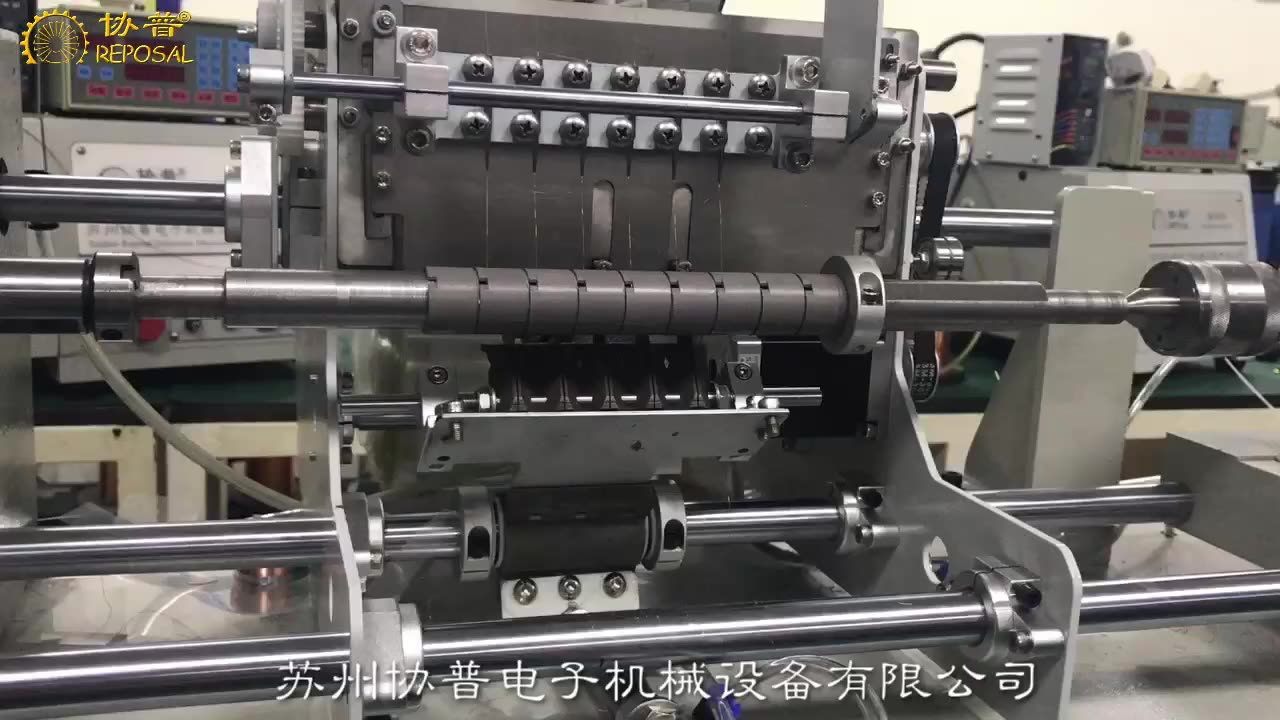
Suzhou Xiepu Electronic Machinery Equipment Co., Ltd. successfully released the SP-D102M7 model of layer-wound high-voltage package automatic interlayer insulation winding machine-this model greatly improves the winding efficiency of layer-wound high-voltage package coils, and the coil is consistent Sex. The REPOSAL® winding machine reduces the winding cost of the layer-wound high-voltage package. In the new model, it has added a compact insulation belt automatic cutting mechanism, and high-quality solutions such as dynamic balance performance after multiple skeletons are wound.
Analysis and Solution of Common Defects in Coil Winding Machine
Analysis and Solution of Common Defects in Coil Winding Machine
one. Bad salt bath:
1. Poor enameled wire: Take out part of the enameled wire from the wire barrel (stretch a few times) and put it in salt water to judge.
2. Poor tension of the winding machine (too large): The rotor wire package placed in salt water bubbles irregularly, and the value rises slowly. (Too small): The wire is easy to hang on the steel sheet during the winding process and the wire package is large and loose.
Solution: The enameled wire passing through the tension system of the winding machine must be checked with a spring balance on the tension meter before winding.
3. Wool felting carbon. Damage to the winding wheel of each winding machine. Damage to the small bearing of each winding: The rotor wire package placed in salt water bubbling irregularly, and the value rises faster.
Solution: Replace the damaged wool felt, thread roller, and small bearing
4. Damage to the winding mold of the winding machine (wire mold): The rotor wire package placed in salt water bubbles regularly, and the bubble position is in the upper, lower or middle of the iron core (each slot is in the same position). The value rises quickly.
(Hook wire set): The rotor wire put in the salt water bubbling on the neck (the damage part should be visible).
Solution: Check the mold. Determine the position. Grind and polish.
5. Poor debugging of the winding machine caused the indexing change during the winding process (and even scratches on the bottom of the enameled wire): the winding mold of the winding machine was not adjusted well at the center of the hook sleeve, and the balance of the winding mold was not adjusted properly. Hook thread set
Analysis of winding tension of loop winding machine
Analysis of winding tension of loop winding machine
Toroidal winding machine-Toroidal coil winding machine-Enameled wire is wound radially on the closed toroidal structure (for details, please refer to the toroidal winding machine tutorial): With the rapid development of the domestic power industry, the demand for current transformer coils Increasingly, the development of current transformer coil winding equipment is imminent. In order to meet the needs of the market, we have developed a current transformer toroidal coil winding machine based on imported equipment. During the design and testing process, we found that, The key to the design of toroidal winding machine is the control of winding tension.
This automatic winding machine is composed of a frame, a pay-off mechanism, a winding head, a tape head, a clamping device, and a control system.
loop winding machine, automatic winding machine,
1, the working principle of toroidal winding machine
Firstly, the wires are evenly wound on the wire storage ring, and then the wires wound on the wire storage ring are wound on the skeleton by a shuttle. The skeleton is driven by the servo motor to rotate, so that the wires are evenly arranged on the skeleton when the wire is wound to a certain amount , And then wind the tape on the frame through the wire storage ring, and then wind it.
2, analysis of winding tension
Through our continuous practice, we have discovered that during the entire winding process, using appropriate force to wind the wire tightly on the skeleton is the key to the quality of the winding. Therefore, we will focus on the factors that affect the winding tension.
1. The grinding moment of the rotating part of the thread bobbin
2. The moment of inertia caused by the acceleration of the thread bobbin part (including the wire wrapped in the bobbin).
The main part of the frictional torque is generated by the tension mechanism, which prevents the wire shuttle from moving and tightens the wire to generate winding tension.
Due to the influence of the winding ring surface and its deviation from the center position in the winding gear, even if the winding is at a constant speed, the movement speed of the thread shuttle is small and uniform, which generates the moment of inertia caused by acceleration, which affects the winding tension.
The movement speed of the thread shuttle can be regarded as composed of two speeds: one is the speed Vo equal to the speed of the pulley on the winding gear, and the other is the speed at which the thread shuttle releases the amount of wire. The former is a constant, and the latter is calculated as follows ( see picture 1)
loop winding machine winding tension analysis 1
So in order to reduce the acceleration of the thread bobbin, it is required:
1. The frame profile H should be small, and the profile should be as close as possible to the center of the winding gear, that is, the value of 1 should be small.
2. The thread hook flat diameter R should be as small as possible.
3. The winding speed ω cannot be too high (this is in conflict with improving production efficiency).
The approximate curve of the speed Vx and acceleration а of the mountain thread shuttle is obtained by the graphical method, and the description is as follows (see Figure 2 and Figure 3):
loop winding machine winding tension analysis 2
1. When the small pulley on the winding gear is at the 0° position, the speed of the thread shuttle is equal to the speed of the small pulley V0, when the speed of the thread shuttle gradually increases from 0-60°, there is a positive acceleration at this time. =600-180`) when the thread shuttle moves at a constant speed, the speed is Vm>Vo. When а=180°~263°, the speed of the thread shuttle gradually decreases. At this time, there is a negative acceleration a = 263°. The speed of the thread shuttle is equal to the pulley speed V. When а=263°~345°, the speed of the thread shuttle continues to decrease. Small, that is, it is lower than V and has a negative acceleration. When а=345°, the speed of the thread shuttle is the minimum Vo, when а=345°~360°, the speed of the thread shuttle increases gradually and there is a positive acceleration.
2. When the winding gear rotates at a constant speed, the speed of the thread shuttle will be zero if it is small, so the friction tension mechanism always acts as a brake to keep the wire tensioned.
3. If Vp is the average linear velocity of the thread bobbin; Vo is the linear velocity of the pulley on the winding gear; L is the perimeter of the wire of the potentiometer, then
4. When the winding speed ω is not large: the wire bobbin diameter R is small, and the potentiometer profile size H is also small. When the profile is as close as possible to the center of the winding gear, the acceleration change is small and large, and the inertia caused by the acceleration The torque is much smaller
Classification and difference of transformer winding machine
Classification and differences of common transformer winding machines
Choosing the right winding machine is the key to the production of coils. There are many types of winding machines as the basic equipment. This article mainly takes transformer winding machines as an example, and talks about its classification and differences, generally according to the voltage level or capacity of the transformer. Division, the common ones are ordinary CNC winding machines, automatic winding machines, foil winding machines, and vertical winding machines, etc.
Common accessories of transformer winding machine
Common accessories of transformer winding machine
The winding process of the transformer winding machine directly affects the formation of the coil, and the experience is constantly summarized in the actual use of the winding machine and applied to the winding operation. Felt is a friction material used to fix the enameled wire, keep the enameled wire stable during operation, and remove dirt and burrs on the surface of the enameled wire. The clamping force of felt is also one of the sources of enameled wire tension. The tensioner is one of the most important components in the online tension device, and it is also the main component of tension control during the operation of the winding machine. Common tensioners are friction, magnetic damping, and magnetic powder braking.

The winding machine needs many accessories to assist the normal operation of the equipment. Common accessories include spools, molds, clamps, tensioners, thread passing devices (mainly explaining the function and composition of the threading device, the threading device plays a role in conveying, protecting, and reversing during the winding operation, so that the enameled wire can be smoothly removed from (The pay-off bucket is transported to the take-up reel)
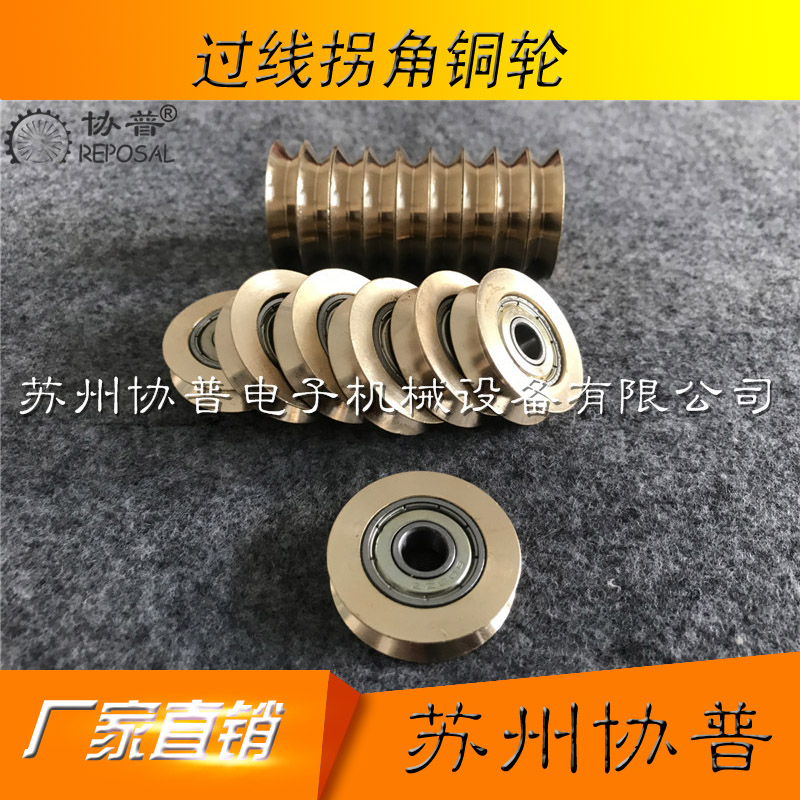
Ceramic wheel is the most common component in stringing equipment. It has two types: full ceramic wheels and semi-ceramic wheels. All ceramic wheels are generally used for multi-wire winding occasions. Its structure is relatively simple, consisting of a bearing and a wheel body. The structure of the semi-ceramic wheel is similar to that of the full ceramic wheel, consisting of a bearing, an inner core, and a plastic retaining ring, and is generally used to wind a single enameled wire.
Debugging method and video of winding machine
Debugging method and video of winding machine
1. Preparation work before turning on the winding machine.
As a kind of precision equipment, in order to keep the winding machine with good working accuracy for a long time, at the same time, the winding machine is a equipment with rotation as the main movement feature. In order to ensure the safety of the process, we need to carefully check the winding machine before the machine. Whether there is debris on the workbench, whether the screws on the winding machine are loose, whether the power switch is properly connected, whether the specification of the enameled wire meets the requirements, confirm that there are no problems with the above problems before starting the machine.
2. Parameter setting of precision winding machine
Press the reset button on the winding machine controller, or press the reset button on the front of the winding machine, the winding machine will automatically reset, at this time, if you need to set the winding machine parameters according to the production schedule. Then press the "step sequence setting" "input" button on the controller of the winding machine in turn, and then press the input key, the cursor will jump backwards in turn at the prompt light on the screen, "starting point", "width" ", "wire diameter", "number of laps", "start winding slow withdrawal", "stop slow", "high speed", "low speed", "wire direction", "winding direction" and other parameters, and finally press "confirm" "Button to confirm, and press the "reset" button to save the data and reset automatically, the parameter setting is completed.
After entering the setting interface according to the step-by-step setting input, pay attention, press the input again to scroll back, and press the-number to scroll forward. When you turn to each parameter, you can enter the corresponding number according to the actual process requirements. For this parameter, you can modify the parameter by typing in the number, or you can adjust the position in real time through the right or right key at the bottom right of the winding machine controller. At the same time, the number in the parameter box will change accordingly in real time.
Design and verification of winding machine for precision voltage transformer
In power transmission and power supply systems such as power plants and substations, voltage transformers are an indispensable electrical appliance. The voltage transformer for measurement specifies the accuracy level of the voltage transformer according to the error generated when the voltage is changed. Voltage transformers of level 0. 2 and above are generally called precision voltage transformers, which are mainly used in the laboratory to expand the measurement limit with the standard meter for precise measurement of voltage, power and electrical energy; or as a standard to check low standards, Low-accuracy voltage transformer; it can also be used with standard meters to test the corresponding meters.
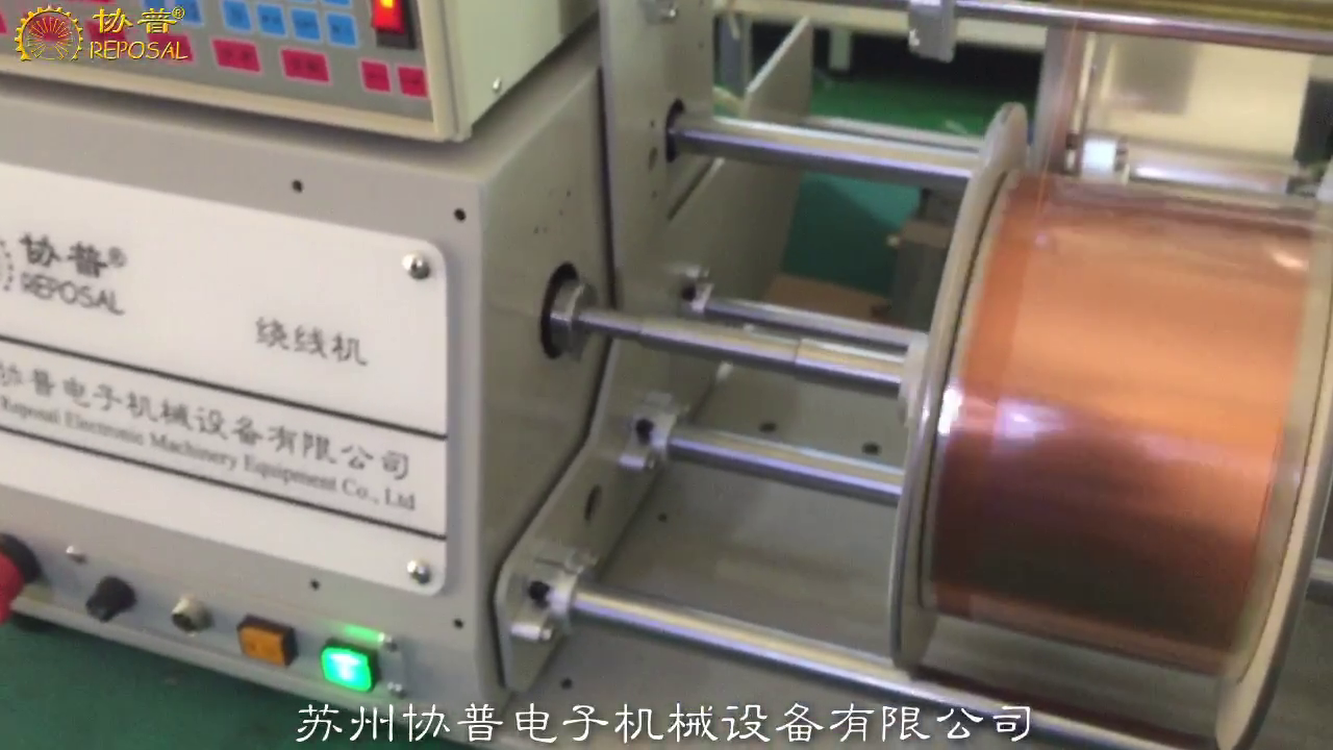
With the rapid development of science and technology and electronic application technology, the requirements for technical indicators such as the rated primary voltage and accuracy of voltage transformers are getting higher and higher, and the demand for various types of voltage transformers is increasing. In the past, voltage transformers were mostly manually wound with annular iron cores and thick enameled wires. The products were large and heavy. In the daily winding, processing and production process, the degree of mechanization was not high, the labor intensity of workers was high, and the production efficiency was low. It is necessary to improve the voltage transformer design process and develop a new type of mechanical equipment for winding the voltage transformer.
Detailed explanation of the operation instructions of the transformer winding machine
Detailed explanation of the operation instructions of the transformer winding machine
Transformer winding machine is a special winding equipment for winding enameled coils of transformers. During the winding process of enameled coils of transformers, winding enameled wire equipment is divided according to the specifications of the transformer. Enameled wire winding machine and foil enameled coil winding machine; there are vertical winding machines and horizontal winding machines for winding enameled coils of large power transformers.
1. Structural characteristics of transformer winding machine:
1. The mechanical transmission part of the winding machine is located inside the headboard, and the electrical part is installed on the top of the headboard. The three-phase asynchronous motor is driven by the frequency converter to realize the linear change of the spindle speed.
2. The winding machine adopts stepless speed regulation, and the controller outputs 0-10V analog voltage, which is connected to the inverter. By means of percentage, there are a total of 100 gears, which can be counted accurately, and can also be counted in reverse to automatically stop.
3. The winding machine can count reversibly, and is equipped with an electromagnetic brake device to prevent reversing when winding the enameled wire to stop, and ensure that the automatic counting will not produce errors. If you need to manually reverse, you can manually press the brake button to release, and the manual rotation can also count.
General technical conditions for parallel winding machine SJ/T 10313—92
People's Republic of China Electronics Industry Standard
General technical conditions for parallel winding machine sj/t 10313—92
General specification of parallel winding machine
1 Subject content and scope of application
This standard specifies the technical requirements, test methods, inspection rules and markings, packaging, transportation and storage requirements for parallel winding machines.
This standard is applicable to parallel winding machines whose skeleton cross-sectional shape is round or rectangular coils.
This standard does not apply to winding machines that wind toroidal, honeycomb, and saddle coils.
2 reference standards
GB191 packaging, storage and transportation pictorial mark
GB4006.1 winding coil cylindrical bobbin type size
GB4006.2 winding coil tapered coil type size
GB4215 Measurement of noise power level of metal cutting machine tools
GB5080.7 Equipment Reliability Test The verification test plan for failure rate and mean time between failures under the assumption of constant failure rate
GB6109.1 enameled round winding wire part one general regulations
Influence of low enameled stress on formability in the process of winding enameled wire by winding machine

1 The formability of the enameled wire The mechanical properties of the enameled wire are divided into the mechanical properties of the conductor and the paint film. In the process of winding the enameled wire, in the wire embedding process, and in the electrical products using the enameled wire coil as a component, mechanical stress acts on the enameled wire during operation, so the enameled wire may be elongated and the paint film is damaged. etc. phenomenon. Therefore, enameled wire has the requirements of elongation, rebound angle, softness, tensile strength, paint film elasticity, paint film adhesion and scratch resistance.
1.1 Mechanical properties of conductors: softness, elongation, rebound angle, and tensile strength.
Elongation reflects the plastic deformation of the material and is used to assess the ductility of enameled wires. The springback angle and softness reflect the elastic deformation of the material and are used to evaluate the softness of the enameled wire. The tensile strength is related to the recovery recrystallization degree of the conductor and the grain size of the recovered tissue. The tensile strength, softness and elongation reflect the quality of the copper material and the degree of enameled annealing, which have a great impact on the quality of the winding. great relationship.
In the process of enameled wire coating, if the number of paint passes and the number of loops is too large, and the diameter of the guide wheel is not large enough, the wire will be continuously deformed by alternating tension and compression, resulting in the distortion of the lattice. It breaks easily when stretched. When the enameled wire is running, the wire is subjected to excessive tension, which will make the wire thinner. At this time, due to the displacement of atoms or ions on the lattice due to sliding, residual internal stress has been formed, so the wire is brittle and elongated. rate and softness rate decreased.
Introduction of winding method of electric heating tube
This type of winding machine of Xiepu has a stroke of 1.5 meters, adopts pneumatic quick assembly and quick disassembly, convenient operation, mature and stable structure, easy maintenance, easy operation of the system, complete functions, and strong expandability.
At present, according to customer requirements, a heating coil with a stroke of up to 1.5 meters is wound on this machine. Because the equipment is structured in place, the winding has a satisfactory effect. The customer currently plans to add mica tape winding function on this basis.

Process requirements of traction motor winding machine
Traction motors are mainly used for railway mainline electric locomotives, industrial and mining electric locomotives, electric drive diesel locomotives and various electric vehicles (such as battery cars, urban trams, subway electric vehicles).
The constraints of the coil during the winding process of the winding machine mainly come from two aspects: design requirements and craftsmanship. The specific manifestations are:
The structural design of coils and windings must not only meet the requirements of electrical performance and temperature rise limit, but also the applicability of existing winding machines, the economical and reasonable use of electromagnetic wires and insulating materials, simple structure and convenient manufacturing, that is, it should have Good manufacturability. In order to achieve better manufacturability and reliability, there are some control points that must be considered in the early stage. For this type of problem, REPOSAL®winding machine shares some content with you.
REPOSAL® machine research on tension control of transformer winding machine
In modern society, electricity is like a surging torrent, injecting strong impetus into our life and production. With the rapid development of China's science and technology and economy, the demand for electricity is increasing day by day, and the demand for transmission and distribution transformers, as an important cornerstone of the power system, is also rising.
The transformer is
the "heart" of the power system, and the winding coil inside it is a
key component of this "heart". The winding quality of the enameled
wire and insulating tape in the winding coil directly determines the
reliability of the transformer. The quality of this winding depends to a large
extent on the performance of the transformer winding machine.
With the sharp
rise in demand for transformers, the performance requirements for transformer
winding machines are becoming more and more demanding. A high-performance
transformer winding machine must not only meet the requirements of safety,
intelligence and high efficiency, but also have high-stability hardware,
easy-to-use software and excellent tension control.
However, at
present, the development of China's transformer winding machine industry is
still facing many challenges. The level of intelligence is relatively low, the
stability needs to be improved, and most of the high-end equipment relies on
imports, and the price is high.
REPOSAL® machine
is well aware of these challenges and has been working hard to improve the
performance and quality of its products. It continues to increase R&D
investment, is committed to improving the intelligent level and stability of
the winding machine, and strives to contribute to the development of the
industry.
When the
transformer winding machine is working, its coil is usually metal wire and
insulating paper, because they have a certain elasticity, the change of coil
conveying speed or roll radius will lead to the change of winding tension. For
example, in the winding and unwinding process, if the angular velocity of the
roll is constant, the change in the radius of the coil will cause tension
fluctuations. If the tension is too large, the coil may become thinner or even
break; If the tension is too small, the material will be unevenly arranged or
wrinkled, which will affect the quality of the transformer winding coil.
Compared with
foreign countries, China's existing domestic transformer winding machine has
deficiencies in tension control. Its tension is usually generated by mechanical
friction, which is not stable enough, which can easily lead to problems such as
sparse arrangement of wires and insulating tapes, and out-of-tolerance of the
outer diameter of the coil. In addition, compared with developed countries in
Europe and the United States, there is a gap in the overall development level
of China's transformer winding machine in terms of processing quality and
production efficiency.
The specific
performance is as follows: First, the processes such as wiring and wiring,
adding insulation layers rely on manual operation, which is inefficient and unstable
in quality. Second, the motor frequently starts, stops and reverses during the
winding process, the tension fluctuates greatly, the coil winding is irregular,
and the quality is difficult to guarantee. Third, the mechanical structure of
the domestic winding machine is relatively simple, and it is not competent for
the winding task of complex coils.
The development of
foreign transformer winding machines is relatively mature. The T-600AH
automatic transformer winding machine from Trishul.Engineers in India can wind
wires and insulating tapes synchronously, with high precision, stable tension
and high efficiency. The EFECO 800 automatic winding machine from
Tuboly.Astronic AG in Switzerland is even more excellent, with high-speed,
high-precision winding and an intelligent cable routing system. The products of
companies such as MTM in Canada, LAE in Italy and UPI in Korea also have high
intelligence and stability.
In terms of tension control research, many scholars have been exploring it in depth since the 90s of the last century. Bastogne T, Koc H and other scholars have pioneered theoretical research and modeling simulation. Entering the 21st century, more scholars are getting involved.
REPOSAL® machine
actively pays attention to the relevant research results at home and abroad,
and applies beneficial theories and technologies to the improvement of its own
products.
The winding
electronically controlled tracking system proposed by Mahawan B et al. in 2001
can still realize the trajectory tracking control of equipment under large
interference. In 2008, Wen P et al. designed a tension control scheme that
allowed the winding speed to be changed under a certain tension fluctuation
while maintaining quality. In 2010, Ponsart J C et al. applied the observer
theory to a transformer winding machine to improve the accuracy of tension
control. In 2017, Mahesh Ghate et al. optimized the tension system for a
specific winding machine and showed good robustness. In 2020, Ma Quanjin et al.
designed a dual-PID tension control system to address the tension fluctuation
problem in a 3-axis fiber winding machine applied with filament winding
technology.
Since the 70s of
the last century, China has begun to develop transformer winding machines, and
has achieved certain results through imitation and the efforts of scholars.
However, due to the monopoly of foreign core technologies, there is still a gap
with foreign countries, especially in terms of manufacturing processes and
control schemes.
At present, the domestic transformer winding machine is mainly in the semi-automatic stage. For example, F. of Dongguan Zongheng Electromechanical Technology Co., Ltd. TWloo CXL transformer winding machine for small and medium-sized transformer coil winding. The ZBR.800/1000/1200 multi-head automatic wiring winding machine of Jiangxi Yibo Automation Equipment Co., Ltd. can realize automatic wire arrangement.
REPOSAL® machine has been committed to promoting the
development of domestic transformer winding machine in the direction of full
automation and intelligence, and constantly optimizing its own manufacturing
process and control scheme.
However, there is still a breakthrough in the layout of
insulating tape and tension control in China, which greatly affects the quality
and production efficiency of the winding coil. Therefore, it is of great
significance to develop a control system that can automatically arrange wires
and insulating tapes with constant tension.
Tension control is a key technology for transformer
winding machine equipment. If the tension is too small, the wire or insulating
tape will slacken, accumulate and wrinkle; Excessive tension can cause it to
deform, stretch excessively, or even break. For transformer winding machines,
the tension control condition directly affects the compactness between the
layers of the winding wires.
At present, there are three main schemes of tension
control: manual, semi-automatic and fully automatic. The manual control needs
to be adjusted manually in stages, the semi-automatic control adjusts the
tension by detecting the change of the roll diameter, and the fully automatic
control is adjusted by directly measuring and feeding back the tension data by
the tension detector.
In the 80s of the last century, manual tension control
was mostly used in China, which was gradually replaced due to the increase in
demand. Since the beginning of this century, domestic scholars have conducted
in-depth research on the automatic tension control system for rewinding and
unwinding.
In 2005, Yang Tao and others from Tianjin Polytechnic
University used a PLC design scheme to accurately control the winding speed of
fine enameled wire. In 2010, Shi Yaoyao et al. studied the discontinuous coil
process and realized winding through the PID algorithm. In 2018, Zhiyong w et
al. established a constant tension control system for the problem of triaxial
fiber winding machine. In 2020, Song Chenliang et al. optimized the tension
adjustment effect of the winding machine through the pendulum tension
adjustment mechanism and the deformed PID control algorithm.
REPOSAL® machine has never stopped exploring tension
control solutions, and constantly tries to innovate to enhance the
competitiveness of products.
However, due to the complex structure of transformer
winding equipment and many influencing factors, the tension control system has
nonlinearity and coupling in different situations, which is still a difficult
point in equipment control. Constant tension control is very important to
ensure the quality of winding, so it is of practical significance to study the
constant tension control system suitable for industrial production.
In the winding coil structure of distribution
transformer, insulating paper tapes need to be arranged between the wire
layers, so the transformer winding coils are usually wound in layers. The
winding process is more complicated, the pilot wire is unwound and sent to the
spindle mold base, during which the oscillating roller adjusts the tension and
speed, and the spindle motor drives the spindle winding. Then the insulating
tape is unwound and sent to the spindle mold base, and multiple coil rolls
cooperate to adjust the tension. Finally, a plurality of motors work together
to drive the spools and other spools for the first layer of winding and arrangement,
after the completion of the wire motor reversal, the pressure roller shears the
insulating paper, the glue sprayer glues, and then the next layer of winding.
Taking Switzerland EFECO 800 transformer winding machine
as an example, its mechanical structure mainly includes spindle mold base,
winding spindle, glue spraying machine, etc. The winding spindle includes a
spindle motor, a reducer, etc., which drives the spindle to rotate and the foot
switch controls the start and stop. The wire winding mechanism has pay-off
wheels, adjusting handwheels, etc., and the insulating tape winding mechanism
has tension feedback devices. The wiring mechanism is composed of a wire spool,
a wire trolley, etc., which can achieve accurate wire arrangement.
For transformer winding machines, the tension control
directly affects the compactness between the winding lines. In practice, the
machining accuracy and the performance of the sensing device will have an
impact on the tension control. For example, the change of reel diameter, the
start-stop and acceleration and deceleration of the reel, the accuracy of
equipment manufacturing and assembly, the forward and reverse rotation of the
motor, and the hardware performance.
There are three ways to test tension. Directly using the
tension sensor to measure, the operation is simple but the limitation is large;
Floating roller tension detection, the measuring device is flexible but the
accuracy is low; Floating roller/feedback composite tension detection, high
accuracy but complex method.
In the process of arranging the transformer winding
machine, the adjustment of the wiring mechanism and the winding position and
the control of the wiring angle are the key to ensure the compactness of the
winding wire.
The cable arrangement mechanism measures the angle
through the rotary encoder on the spindle and transmits the data to the
controller, and the controller drives the wire motor after processing to
realize the speed coupling of winding and wire arrangement.
In the actual winding, the tension of the wire and the
insulating tape should be kept constant and cooperate with the wire
arrangement. In the automatic wiring control scheme, the main controller
controls the motor unit to work together, the spindle and the wiring mechanism
cooperate with the layered winding, the encoder feeds back the data in real
time, and adjusts the speed of each axis according to the control algorithm to
ensure the accuracy of the wiring.
The angle of the cable is very important, too large or
too small will affect the effect of the line. When winding, the line is
adjusted according to the change in angle, the feed rate is brought in, and the
overall trajectory is followed. Since winding is carried out in layers, divided
into wire layers (odd layers) and insulating layers (even layers), the wire
laying process can be divided into multiple stages and cycles.
The automatic wiring of the transformer winding machine
has high requirements for the motor control algorithm, which requires the
coordinated operation of the motors of each shaft and the close cooperation of
the drive actuator to jointly complete the automatic winding and arrangement of
the transformer coil. The common multi-motor cooperative control structures
include parallel synchronous control, master-slave motor control,
cross-coupling collaborative control, adjacent cross-coupling control and
deviation coupling step control, each with its own advantages and
disadvantages.
In conclusion, transformer winding machines are very
important in the power field. Although China has made certain achievements in
this field, it still needs to make continuous efforts to strengthen independent
research and development, improve the technical level, narrow the gap with
foreign countries, promote the development of the industry, and contribute more
to the power industry. REPOSAL® machine will continue to uphold the spirit of
innovation and enterprising, and make unremitting efforts to improve the
overall level of China's transformer winding machine.
Research and development of horseshoe hollow cup motor coil and winding machine
Research and development of horseshoe hollow cup motor coil and winding machine
In recent years, China has paid more and more attention to hollow cup motor and automatic winding technology, and has made good progress and breakthroughs in the research and development and manufacturing of winding machine equipment.
One of the key reasons for the impact on the performance of the motor is the rotor coil in the motor, the rotor in the hollow cup motor has no iron core, small inertia, excellent functionality and a wide range of applications. In addition, in the research and development of coil winding equipment, the saddle-shaped coil arrangement is regular, and the utilization efficiency of magnets is high.
Compared with the old traditional motor with an iron core, the energy conversion efficiency is significantly higher than the latter, and the reaction speed will be much faster, and the hollow cup motor has high efficiency, fast response speed and stable performance. Because the hollow cup motor has no lag, additional electromagnetic interference is low, very high motor speed can be achieved, and the speed setting is sensitive at high speed, so it has relatively stable and stable performance. In addition, the energy density of the hollow cup motor is much greater than that of other motors, and the weight will be much less than that of an iron core motor with the same power.
Now according to the forming method of the coil, in the hollow cup motor coil, its production technology can be roughly divided into two process routes: winding production technology and one molding production technology.
Compared with the two methods, the first winding production technology is more complex, and the efficiency of winding the coil is relatively low. In order to improve the winding efficiency of coil production, the winding machine can be added to the production process of one molding. According to the hollow cup coil shape and winding method, the common hollow cup winding method can be divided into three kinds of parallel straight winding, saddle winding and oblique winding. The first parallel straight winding is generally used for hollow cup motor winding with relatively few turns. The last two are the two coil winding processes commonly used by the relatively advanced hollow cup motor manufacturers abroad.
REPOSAL® has successfully released a radiofrequency ablation catheter winding machine
Radiofrequency ablation has ablation and cutting functions, and the main therapeutic mechanism is thermal effect. Radio frequency refers to radio frequency, frequency up to 150,000 times per second of high frequency vibration, but it does not belong to the division of bands in radio communication.
The coiling process is completed by continuous test and optimization of the coiling machine.
The working flow of this winding machine is as follows:
1. The active wire feeding device of the radiofrequency ablation catheter winding machine ensures that the wires are constantly connected and not tied.
2. Double fold section A measurement line.
3. Manual folding head.
4. Manually fix the thread head (Two schemes are tentatively proposed for fixing the thread head)
4.1 Fix the starting position with glue. The fixture locks the PEEK tube.
4.2 Kangtong wire is hung on the feature of steel pipe. Glue to fix the ends after wrapping.)
5. Press the start button of the radiofrequency ablation catheter winding machine to wrap.
6.(During the winding process of the radiofrequency ablation catheter winding machine, both AB and AB segments have adjustable tension)
7. Wrap the jump grid to the specified position (the specific hop length can be set, and the rotation Angle can be set.
8. After the radiofrequency ablation catheter winding machine is finished, the feeder stops at the end and maintains tension.
9. Fix the end of the line by manual dispensing
10. Both ends of the radiofrequency ablation catheter winding machine are coaxial, and the rotation direction is synchronized.
11. Adjustable pre-drawing force is required at both ends of the locking shaft core.






